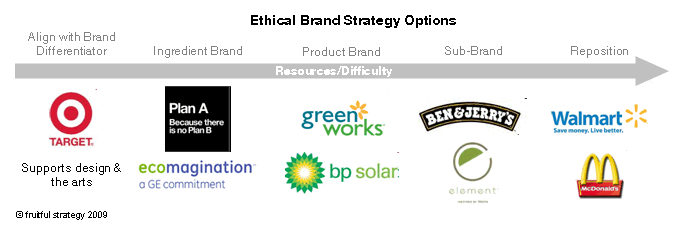Five Strategies for Building Your Ethical Brand
[Editor's note: Welcome to guest contributor Jennifer Rice! Jennifer is Principal of Fruitful Strategy, a San Francisco-based firm that helps companies build values-based reputations through brand (re)positioning, customer experience design, and innovation.]
There’s been a lot of discussion about elevating corporate responsibility to become a strategic driver of your business. Most companies would like to benefit from their ethical efforts in the form of increased customer attraction and loyalty, yet few have figured out how to do it successfully. When marketing and PR are relied on, it can often backfire in accusations of greenwashing. The secret is to apply brand-strategy principles to build your ethical reputation.
Brand: Who you are, not what you say
First, let’s back up and define what a brand is. More than a logo, tagline or campaign, a brand is a promise delivered. It’s no longer about marketing; it’s about co-creating your reputation with your customers and managing perceptions through your actions. That means your brand could be favorable or unfavorable, depending on how you interact within your ecosystem and whether you’ve actively managed your brand or not.
A brand strategy is, in essence, a focused strategic platform that guides every aspect of the business. It should incorporate 4Ds: desirable by customers, deliverable by the company, distinctive from the competition, and durable over time. It’s a blueprint for how you do business, as well as for the entire customer experience.
Since brand is inherently about building a reputation, it’s not a stretch to say that strategic CSR is all about brand-building… not philanthropy or community programs. The latter are among the tactics to be judiciously identified and tailored to support a desired outcome, which should be to build a clear, consistent and believable reputation among your constituents that engenders preference and loyalty. That desired outcome informs the entire customer experience as well as how you do business.
Five strategies for aligning brand with values
There are five brand strategy approaches that are directly relevant to building your ethical reputation.
1. Align with Brand Differentiator
Ideally your ethical initiatives will directly support your brand promise. Remember, a brand is a promise delivered… so consider what makes your brand unique from competitors and develop key initiatives to support that. For example, one of Target’s philanthropy programs is to support the arts and design, which directly supports Target’s “affordable design†brand differentiator. Instead of cutting your CSR programs during the downturn, consider shifting resources from generic programs to those that support and drive not just your category, but your brand.
2. Create an Ingredient Brand
Think Westin’s Heavenly Bed or, in the CSR space, Marks & Spencer’s Plan A or GE’s Ecomagination. This is the ‘special sauce’ that makes your brand preferable to values-based buyers and employees. Creating a brand for your ethical initiatives accomplishes several important objectives:
- Helps clarify for employees and customers your ethical value proposition
- Makes it easier to allocate human and financial resources to your initiative (hint: assign a brand manager to own, drive and measure)
- Serves as a growth platform for customer experiences, products and services
- Elevates your social and environmental initiatives above me-too commodity status.
There are a few risks of goodwashing with this approach, so be sure that everyone is committed to creating something of unique value that’s completely aligned with the vision and values of the parent brand. And any misstep by the parent brand may end up discrediting the hard work done to build the ethical ingredient brand.
3. Create a Product Brand
If there are values-driven buyers in your category (highly likely), consider launching a product just for them. Clorox GreenWorks and BP Solar are good examples. Note that these brands are tied closely to their parent brands, so don’t consider this option unless the parent company is doing its part on the ethics front. But a product brand is an excellent opportunity to help customers experience your values and simultaneously boost the profit part of the triple bottom line. Case in point, GreenWorks has now captured 42% of the natural cleaner category in a little over a year.
4. Create a New Sub-Brand
A separate brand (with its own customer experience, distribution channels, etc.) that’s completely anchored on the triple-bottom line puts a bit of distance between it and the parent company. Good examples include Starwood’s Element or, through acquisition, Unilever’s Ben & Jerry’s. Why use a sub-brand strategy?
- To lead your category in capturing hearts and minds of values-oriented consumers without being saddled with baggage of the parent company
- To minimize claims of greenwashing, as all actions of the sub-brand are (should be) congruent.
- To help “turn the Titanic†and reposition the parent company as an ethical brand. The parent company can “borrow†the positive brand equity from the sub-brand while going through the process of cleaning up its act.
Acquisition is the easier route, but often the ethical brand gets flack for “selling out†if it’s not handled carefully, and core values still need to be aligned. Building it yourself is harder, but the benefits could easily outweigh the effort required.
5. Reposition the Brand
This option is especially important for companies with a history of contributing to the problems of the planet rather than the solutions. Formerly “evil†companies like Wal-Mart, McDonald’s and BP have made great strides in redefining their brands as more responsible. With a very large company, this is a process that takes years and top-down dedicated effort to fundamentally change the essence and ethos of the company. For a smaller brand it’s definitely easier.
No hard and fast rules
Please note that there are no easy answers or guidelines here. The most appropriate approach for your company depends on the unique combination of your customers, their expectations and perceptions of your brand versus other options, the progress you’ve made in the ethical realm, whether or not you actually have a clearly defined brand promise, the commitment level from your executive team… I could go on, but you get the point.
I’m happy to have a preliminary discussion with you about the right approach and key considerations for your business; just contact me at jennifer@fruitfulstrategy.com.
This post was originally published at Fruitful Strategy and is reprinted with permission.



